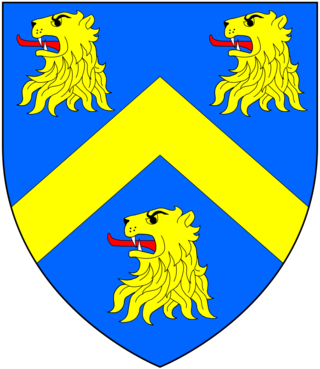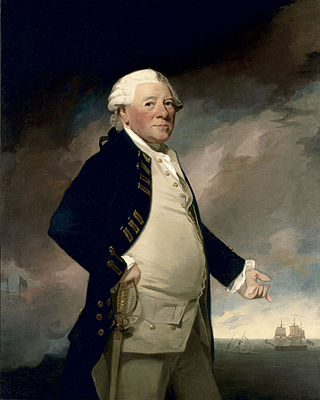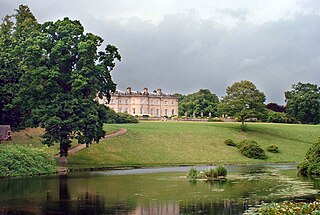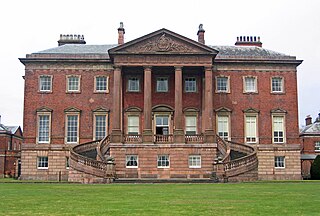
Viscount Gage, of Castle Island in the County of Kerry of the Kingdom of Ireland, is a title in the Peerage of Ireland. It was created in 1720 for Thomas Gage, along with the subsidiary title of Baron Gage, of Castlebar in the County of Mayo, also in the Peerage of Ireland. In 1744 he also succeeded his cousin as eighth Baronet, of Firle Place. The titles remain united. The Gage family descends from John Gage, who was created a baronet, of Firle Place in the County of Sussex, in the Baronetage of England on 26 March 1622. His great-grandson, the seventh Baronet, represented Seaford in Parliament. He was succeeded by his first cousin, Thomas Gage, 1st Viscount Gage, the eighth Baronet. He sat as a Member of Parliament for Minehead and Tewkesbury and also served as Governor of Barbados. In 1720, 24 years before succeeding in the baronetcy, he was raised to the Peerage of Ireland as Baron Gage and Viscount Gage. His second son was the military commander the Hon. Thomas Gage.

Earl of Egremont was a title in the Peerage of Great Britain. It was created in 1749, along with the subsidiary title Baron of Cockermouth, in Cumberland, for Algernon Seymour, 7th Duke of Somerset, with remainder to his nephews Sir Charles Wyndham, 4th Baronet, of Orchard Wyndham, and Percy Wyndham-O'Brien. The Duke had previously inherited the Percy estates, including the lands of Egremont in Cumberland, from his mother Lady Elizabeth Percy, daughter and heiress of Joceline Percy, 11th Earl of Northumberland. In 1750 Sir Charles Wyndham succeeded according to the special remainder as second Earl of Egremont on the death of his uncle. His younger brother Percy Wyndham-O'Brien was created Earl of Thomond in 1756.

There have been seven Baronetcies created for persons with the surname Lewis, two in the Baronetage of England and five in the Baronetage of the United Kingdom. Only one creation is extant as of 2010.
There have been ten baronetcies created for persons with the surname Mackenzie, seven in the Baronetage of Nova Scotia and three in the Baronetage of the United Kingdom. Four of the creations are extant as of 2010.
There have been five baronetcies created for people with the surname Napier, three in the Baronetage of England, one in the Baronetage of Nova Scotia and one in the Baronetage of the United Kingdom. As of 2014 two of the creations are extant.

The Bunbury Baronetcy, of Bunbury, Oxon and Stanney Hall in the County of Chester, is a title in the Baronetage of England. It was created on 29 June 1681 for Thomas Bunbury, Sheriff of Cheshire from 1673 to 1674 and the member of an ancient Cheshire family. His grandson, Henry, the third Baronet, and great-grandson, the fourth Baronet, both sat as Members of Parliament for Chester. The latter died unmarried at an early age and was succeeded by his younger brother, the fifth Baronet. He was a clergyman. On his death in 1764 the title passed to his eldest son, the sixth Baronet. He represented Suffolk in the House of Commons for over forty years but is best remembered for his marriage to Lady Sarah Lennox. He died childless in 1821 and was succeeded by his nephew, the seventh Baronet. He was the son of Henry Bunbury, younger son of the fifth Baronet. The seventh Baronet was a distinguished soldier and politician. His eldest son, the eighth Baronet, was High Sheriff of Suffolk in 1868, and Fellow of the Royal Society. He died childless in 1886 and was succeeded by his younger brother, the ninth Baronet. He was Liberal Member of Parliament for Bury St Edmunds. He died unmarried in 1895 and was succeeded by his nephew, the tenth Baronet. He was the son of Colonel Henry William St Pierre Bunbury, third son of the seventh Baronet. He served as High Sheriff of Suffolk in 1908 and was a Deputy Lieutenant of the county. On his death in 1930 the title passed to his son, the eleventh Baronet. He was High Sheriff of Suffolk in 1936 and was a Deputy Lieutenant of the county. His son, the twelfth Baronet, was High Sheriff of Suffolk in 1972. As of 2014 the title was held by the latter's second but eldest surviving son, the thirteenth Baronet, who succeeded in 1985.
There have been three baronetcies created for members of the Stonhouse family, all in the Baronetage of England. Two of the creations are extant as of 2021.
The Tennyson d'Eyncourt Baronetcy, of Carter's Corner Farm in the Parish of Herstmonceux in the County of Sussex, is a title in the Baronetage of the United Kingdom. It was created on 3 February 1930 for the naval architect Eustace Tennyson d'Eyncourt. He was a grandson of Charles Tennyson d'Eyncourt.

There have been seven baronetcies created for persons with the surname Parker, three in the Baronetage of England, two in the Baronetage of Great Britain and two in the Baronetage of the United Kingdom. Two of the creations are extant as of 2008. Though none of the different families of baronets were related, several supplied a number of flag officers to the Royal Navy.
There have been nine baronetcies created for persons with the surname Lloyd, three in the Baronetage of England, three in the Baronetage of Great Britain and three in the Baronetage of the United Kingdom. Two of the creations are extant as of 2010.

There have been four baronetcies created for persons with the surname Miller, two in the Baronetage of England, one in the Baronetage of Great Britain and one in the Baronetage of the United Kingdom. Two of the creations are extant as of 2008.

The Chance Baronetcy, of Grand Avenue in the parish of Hove in the County of Sussex, is a title in the Baronetage of the United Kingdom. It was created on 19 June 1900 for James Timmins Chance, a grandson of William Chance one of the Chance brothers who started the family business in 1771. He became head of Chance Brothers and Company. He was High Sheriff of Staffordshire in 1868.
There have been six baronetcies created for persons with the surname Thomas, three in the Baronetage of England, one in the Baronetage of Great Britain and two in the Baronetage of the United Kingdom. Two of the creations are extant as of 2016.

The Fagge Baronetcy, of Wiston in the County of Sussex, is a title in the Baronetage of England.

There have been two baronetcies created for persons with the surname Goring, both in the Baronetage of England. The second creation came into the family through a special remainder in the patent creating the baronetcy. Only the latter creation is extant as of 2008.

There have been five baronetcies created for persons with the surname Kennedy, one in the Baronetage of Ireland, three in the Baronetage of Nova Scotia and one in the Baronetage of the United Kingdom. One creation is extant as of 2010.

There have been seven baronetcies created for persons with the surname Herbert, three in the Baronetage of England, one in the Baronetage of Ireland and three in the Baronetage of the United Kingdom. All creations are extinct.

There have been four baronetcies created for persons with the surname Martin, one in the Baronetage of England, one in the Baronetage of Great Britain and two in the Baronetage of the United Kingdom. All creations are now extinct.

There have been two baronetcies created for persons with the surname Leicester, both in the Baronetage of England. The fifth Baronet of the second creation was raised to the peerage as Baron de Tabley in 1826. Both the barony and the two baronetcies are now extinct.

Sir Robert Fagg, 4th Baronet (1704–1740), of Wiston, near Steyning, Sussex, was a British politician who sat in the House of Commons from 1734 to 1740.














